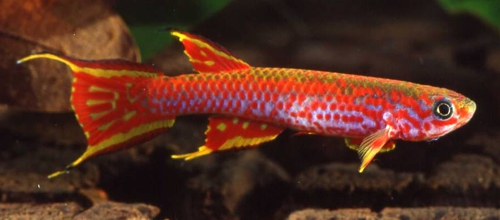

A.rectogoense GHP 80 / 30. Photo courtesy of Gottfried Marschitz
| Meaning of Name |
Recto = true, ogoense = the Ogooue River, Gabon. | ||||||||||||||||||||||||||||||||
| First Description |
Radda A.C. & Huber J.H. 1977. Cyprinodontiden Studien in Gabon III. Zentral und Südostgabun. Aquaria 24: p 64-66, figures 3,6. | ||||||||||||||||||||||||||||||||
| Size |
5cm | ||||||||||||||||||||||||||||||||
| Meristics |
D = 8-9, A = 14, D/A = +9-11, ll = 27-29 (+2-3) (Radda & Huber 1977) | ||||||||||||||||||||||||||||||||
| Karyotype |
n = 9, A = 18 (Huber & Scheel 1981) | ||||||||||||||||||||||||||||||||
| Sub-Genus |
Aphyosemion | ||||||||||||||||||||||||||||||||
| Group |
elegans | ||||||||||||||||||||||||||||||||
| Synonyms |
| ||||||||||||||||||||||||||||||||
| Populations
|
BBA-GAB 90/27 - Collected
11th August 1990 at 13.05 hrs. Location was 46 kms east of the centre
of a large river bridge in Franceville leading via Bongoville to Leconi
(Lekoni) near the Congo border. This was 7 kms east of Bongoville.
Habitat was a roadside pool 12 metres in diameter which lay on the
right hand or south side of the road travelling east. At the time
of collecting it was cloudy but the pool was open to sunlight. Air
temperature was 27°C, water was 25°C, clear & slightly
brown. No apparent water flow. The pH was 5·7 & DH 0·5
or less. BBA-GAB 90/28 - Collected by David Armitage, Allan & Barbara Brown 1990. Collected Sunday 12th August at 13.30 - 14.30 pm. Location was a stream passing under a culvert 31·7kms north of Franceville on the road to Okondja & 13·4kms south of the Leconi river (tributary of the Ogooué). Reportedly not the R15 road via Akieni but the road directly north from Franceville via Motobo, Okoloville & Mbounga. A patch of forest in an area of scrub & grass. Air temperature 25°C, water temperature 23°C, pH 6·3, DH <1, water depth 30cm. Stream base was clay & sand. No aquatic plants. Shade from trees 7/8ths. Width of stream 3 metres & flow at this point 1 metre in 13 seconds to 6 metres wide at 1 metre in 60 seconds. Sympatric species Plataplocheilus terveri, Ctenopoma nanum, barbs & loaches.
Brosset 79 / 235 - These codes carried on from Hubers' JH numbers.Collected by Brosset in 1979 at Poubara Bridge, southeast of Franceville, southeast Gabon. EBT 96 / 1 - Same location as PEG 95 / 16.
G 76 / 11 - This code also known as JH 76 / 11 or GJH 76 / 11. This is the type locality. Collected by Dr.J.H.Huber & A.C.Radda in 1976, 6 kms west of Léconi towards Franceville, southeast Gabon. G 76 / 14 - This code also known as JH 76 / 14 or GJH 76 / 14. Near the Kéléomoy crossroads, M'Passa basin. GHP 80 / 30 - Collected 31 kms from Franceville towards Bongov, southeast Gabon. Collected by Hofmann & Pürzl in 1980. Imported as F1 fish by BKA Species Import Committee in June/July 1981.
PEG 95 / 16 - Ferme Ampéné, on the PK 2, west of Léconi. Collected by Passaro & Eberl in 1995.
| ||||||||||||||||||||||||||||||||
| Type Locality |
6
km west of Léconi on the new road from Franceville to Bongoville, southeastern
Gabon. The biotope was a brook in the Djouele, Léconi drainage system (G76/11). | ||||||||||||||||||||||||||||||||
| Distribution |
Southeastern Gabon on the savannah of the Bateke
highlands. They inhabit the upper Lékoni-Djouya & upper Mpassa
River drainage systems. | ||||||||||||||||||||||||||||||||
| Habitat |
Savannah brooks. Altitude approx. 500 metres.
Biotope near Leconi,
Gabon, collecting place of A.rectogoense
and E.boulengeri. | ||||||||||||||||||||||||||||||||
| Distinguishing Characteristics | A heavy covering of red spots on body over a yellow background. Perhaps the distinguishing point being the caudal fin where the caudal peduncle half is spotted with the rear showwing horizontal flares of red. | ||||||||||||||||||||||||||||||||
| Colour/Pattern Variability | Fairly low. | ||||||||||||||||||||||||||||||||
| History |
Discovered by Radda & Huber in 1976 in the Bateké
uplands of Gabon. | ||||||||||||||||||||||||||||||||
| Breeding Notes |
Wild fish are reportedly more prolific than aquarium bred fish. Water incubation takes 10-12 days. Growth is fairly slow taking around 7 months to reach sexual maturity. Lothar Seegers gives a breeding report in BKA
newsletter No.220, December 1983. He found the pair layed on the bottom
of the tank. The tank was filled with Java moss. When tried in a bare
tank with a long floating mop the pair spawned at all levels. He considered
the key to breeding this sp. lies in their diet which should consist
of mosquito larvae & other fly larvae with worm type food offered
less often. Tony Pinto in BKA Newsletter No.332 reported
eggs developing from 10 - 21 days depending on water temperature. Success
was had storing eggs on damp peat. Fry were small & best fed infusoria
for the first few days. | ||||||||||||||||||||||||||||||||
| Diameter of Egg | 1mm (Tony Pinto - BKA Newsletter No.332, May 1993). | ||||||||||||||||||||||||||||||||
| Remarks |
|